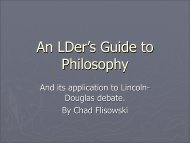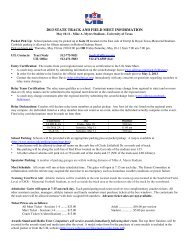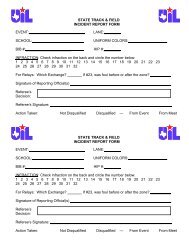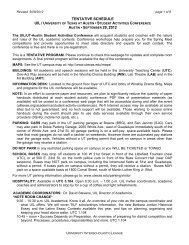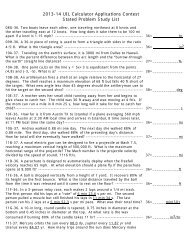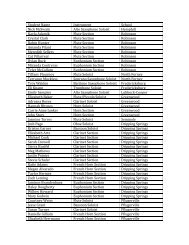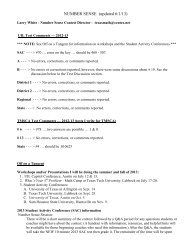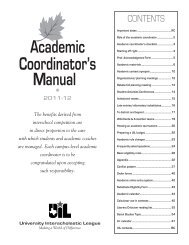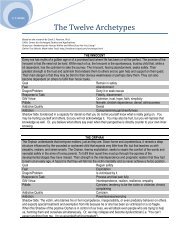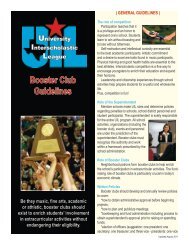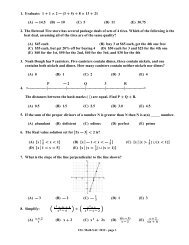Cross Examination (CX) Debate
Cross Examination (CX) Debate
Cross Examination (CX) Debate
You also want an ePaper? Increase the reach of your titles
YUMPU automatically turns print PDFs into web optimized ePapers that Google loves.
<strong>Cross</strong> <strong>Examination</strong> (<strong>CX</strong>)<br />
<strong>Debate</strong><br />
Overview
Affirmative Case Structure<br />
Topicality<br />
Founded on Definitions<br />
Significance<br />
Walls (Harms) frame the<br />
issue<br />
Plan/Solvency<br />
Covers all harms<br />
Inherency<br />
Inherent Barrier<br />
Advantages<br />
Extras (bonus benefits)
<strong>CX</strong> <strong>Debate</strong><br />
Topicality
Review<br />
Affirmative Case Structure<br />
Topicality<br />
Significance (Harms)<br />
Inherency<br />
Solvency<br />
Advantages
Topicality<br />
Resolved: The United States federal<br />
government should substantially<br />
increase its transportation<br />
infrastructure investment in the<br />
United States.<br />
Define each word<br />
Have definitions and standards for all<br />
terms
Types Of Standards<br />
Legal definitions<br />
Bright line<br />
Framer’s intent<br />
Each word has a<br />
meaning<br />
Set a Standard<br />
Make sure you have<br />
standards to support
Check Your Sources<br />
Possible Dictionaries<br />
Black ‘s Law Dictionary<br />
Words and Phrases<br />
Webster’s New World<br />
On-line Dictionaries<br />
Webster’s New<br />
Collegiate<br />
STAY AWAY FROM<br />
WIKIPEDIA
Run To Government Documents<br />
Government<br />
documents may prove<br />
each word has<br />
meaning<br />
Example:<br />
Transportation<br />
infrastructure
Apply To Case<br />
MAKE SURE YOUR DEFINITIONS FIT<br />
YOUR CASE BECAUSE THE NEGATIVE<br />
TEAM WILL PRESENT COUNTER<br />
DEFINTIONS
Questions<br />
?
<strong>CX</strong> <strong>Debate</strong><br />
Harms
Review<br />
Affirmative Case Structure<br />
Topicality<br />
Significance<br />
Inherency<br />
Solvency<br />
Advantages
Significance<br />
Answers the Question:<br />
“What is the Harm in the Status Quo?”<br />
Status Quo<br />
“The current situation, the problem that the<br />
topic is seeking to repair”<br />
“The way things are now.”<br />
(Debating Policies, p. 43)
Harms are:<br />
Significance<br />
Claims about what in the status quo is bad<br />
Quantifiable or Unquantifiable:<br />
Quantifiable: Perhaps 50 million people are<br />
currently harmed by transporatation infrastructure<br />
Unquantifiable : Loss of freedom or unethical<br />
corporate behavior<br />
Both quantifiable and unquantifiable harms are<br />
strong.
Harm 1 - Title<br />
Subpoint A) – Tag Line<br />
Citation<br />
Evidence (i.e., “Card”)<br />
Subpoint B) – Tag Line<br />
Citation<br />
Evidence (i.e., “Card”)<br />
Subpoint C) – Tag Line<br />
Citation<br />
Evidence (i.e., “Card”)<br />
Significance<br />
Tag Line<br />
5-7 Word to Summary<br />
Citation<br />
Author [Title]<br />
OR<br />
Organization<br />
Date<br />
URL (if applicable)<br />
Rules of Evidence<br />
Whole sentences<br />
Underline key<br />
sentances
Example<br />
Harm 3 – Current US Incentive Structure Counterproductive<br />
A) Current Incentives Benefit Fossil Fuels<br />
[Steve Stein [financial adviser], Policy Review, August-September 2006, p. 53]<br />
AFF CASE – Ethanol<br />
The 2005 act [Energy Policy Act of 2005] certainly hasn't made energy policy more coherent.<br />
Consider, for example, the structure of incentives for purchasing vehicles. A small-business owner, like<br />
anyone else, can obtain up to a $3,150 credit for buying a hybrid car. But if that same business owner buys<br />
a Hummer or other large SUV instead, he's eligible for tax deductions that are potentially several times that<br />
amount. Since these large SUVs qualify as "trucks," the purchaser obtains an immediate deduction of up to<br />
$25,000 by showing that the vehicle is used entirely for work and receives an accelerated depreciation<br />
allowance on the balance. The liberal depreciation of SUVs and their exemption from fuel efficiency<br />
standards were enacted to help the domestic car industry, but "oil addiction" can't be ended by subsidizing<br />
its use.<br />
B) Major Automakers Promoting Inefficient SUVs<br />
]The Boston Globe, “GM AND FORD GAS DELUSIONS,” July 09, 2006, p. E8, LexisNexis]<br />
“THE TWO TOP US car makers, General Motors and Ford, could have responded to the past year's<br />
steep hike in gasoline prices by building more small cars and more cars of all sizes using fuel-saving hybrid<br />
engines. Instead, first GM and then Ford decided to make their gas-guzzling models more attractive by<br />
offering cash to car buyers for their high gas-pump bills. Whatever gains in sales this incentive provides, it<br />
will only worsen the nation's dependence on foreign oil and its reputation for leading the world in<br />
greenhouse gas emissions.<br />
The GM deal offered unlimited gasoline at $1.99 a gasoline for a year to buyers in California and<br />
Florida of many of its larger models, and none of its most fuel-efficient models. Ford is offering $1,000 in<br />
free gasoline to buyers of many of its 2006 models.
<strong>CX</strong> <strong>Debate</strong><br />
Inherency
Inherency<br />
Answers the Question:<br />
“What’s preventing your plan from happening<br />
today (i.e. in the status quo)?”<br />
Claim that the status quo will not be changed<br />
As a result, harms will continue indefinitely
Inherency – Title<br />
Tag line<br />
Citation<br />
Evidence<br />
Tag line<br />
Citation<br />
Evidence<br />
1 to 2 cards<br />
Inherency<br />
Types of Inherency<br />
Structural<br />
What is preventing your<br />
plan ….<br />
Attitudinal<br />
Who is preventing your<br />
plan …<br />
Existential<br />
No Infrastructure exists<br />
to solve
<strong>CX</strong> <strong>Debate</strong><br />
Solvency
The Plan<br />
Is your proposed course of<br />
action to solve for the harms.<br />
Written in your own words.<br />
Should be simple,<br />
straightforward
Structure:<br />
The Plan<br />
Plank 1) Agent of Change<br />
What agency will make the change?<br />
Plank 2) Mandates<br />
What steps must go into<br />
implementing this change<br />
Legislative changes<br />
Judicial decisions<br />
Executive agencies/ policy changes
Structure:<br />
Plank Funding<br />
The Plan<br />
Where exactly is the money coming from<br />
Normal means<br />
Funding source – have<br />
evidence on how much and<br />
from where<br />
Anticipate DAs
Structure:<br />
The Plan<br />
Planks XX) Enforcement<br />
What agency will implement/enforce this change?<br />
Normal means<br />
Executive department<br />
“All speeches serve to clarify<br />
legislative intent”
Plan<br />
Example<br />
Plank 1) Agent of change – The United States federal government<br />
AFF CASE – Ethanol<br />
Plank 2) Congress will model the California and Texas auto incentive programs and<br />
implement a nationwide program for consumers who meet predetermined income<br />
requirements to trade in a vehicle 10 years old or older for a $3,000 to $5,000 credit<br />
toward the purchase of a new or used flex fuel vehicle.<br />
Plank 3) The plan will be enacted January 1 through December 31, 2009.<br />
Plank 4) Funding shall come through funds currently set aside for fossil fuel<br />
incentive programs set aside by the Energy Policy Act of 2005.<br />
Plank 5) Enforcement shall be through normal legislative means.<br />
All speeches serve to clarify legislative intent.
Solvency<br />
The argument that your plan would work.<br />
Responds to questions such as:<br />
Will the funding for the plan work out?<br />
Will the funding be sufficient?<br />
Will it solve the harms?
Solvency<br />
Where the rubber meets the road<br />
Plan-Meets-Need<br />
Does the plan solve for all harms?<br />
Does the plan remove the Inherent Barrier<br />
Beyond solvency for the problems, does plan<br />
have any other net benefits/harms?<br />
Plan benefits = Advantages<br />
Plan harms = Disadvantages<br />
Learn to anticipate likely Neg. DAs
Solvency<br />
Example<br />
A) California Shows That Vehicle Incentives Work<br />
[INVESTOR'S BUSINESS DAILY, April 22, 2008]<br />
AFF CASE – Ethanol<br />
In the 1990s, California launched a voluntary vehicle retirement program. In some air quality<br />
management districts, owners of older, gross-polluting cars are paid cash to scrap them. The state also pays<br />
out $1,000 to low-income car owners who would rather scrap their vehicles. The average age of the cars<br />
retired in these local programs is 18 years. They are replaced with cars that are, on average, 10 years old,<br />
one year older than the average of the state's fleet. With fewer old cars on the road and more cars nearer the<br />
average age, emissions are reduced. So why not something similar on the national level? We would expect<br />
gasoline use to fall — lowering emissions, just as happened in California — as the fleet got younger and<br />
the average fuel economy increased. Such a program would be voluntary but it's important to remove from<br />
the fleet the old gas guzzlers. It's safe to say that most of those polluters also have poor fuel economy. So<br />
removing 14 million low-mileage vehicles and replacing them with higher-mileage cars would effectively<br />
cut fuel demand.<br />
B) Flex-Fuel Vehicles Worked In Brazil<br />
[The International Herald Tribune, May 28, 2008, Palmer]<br />
<br />
Brazil started a national program to stimulate consumption and production in the 1970s. The most<br />
recent boost to the program came in 2003, with the introduction of flex-fuel vehicles that can run on<br />
gasoline, ethanol or a mixture of the two. In Brazil, ethanol consumption surpassed that of gasoline this<br />
year for the first time in two decades.<br />
C) Current Infrastructure Exists to Replace Gasoline Imports<br />
[Vinod Khosla, The Washington Post, June 16, 2008 Monday, Palmer]<br />
http://www.washingtonpost.com/wp-dyn/content/article/2008/06/15/AR2008061501454.html
<strong>CX</strong> <strong>Debate</strong><br />
Advantages
Review<br />
Affirmative Case Structure<br />
Topicality<br />
Significance<br />
Inherency<br />
Solvency<br />
Advantages
Link to plan<br />
Advantages<br />
A plank of the plan would result in Advantage<br />
Not extra-topical<br />
Stay within resolution<br />
Evidence based<br />
Not solvency/Unique advantages<br />
(i.e. economic, efficiency, advances)<br />
Have impacts (importance)<br />
Be able to weigh versus disadvantages (DAs)
<strong>CX</strong> <strong>Debate</strong><br />
Final Case Requirements
Requirements<br />
Definitions<br />
Harm 1<br />
Harm 2<br />
Harm 3<br />
Inherency<br />
Plan<br />
Solvency<br />
Advantage 1<br />
Advantage 2<br />
Final Case<br />
8:00 min. total<br />
In page protectors in<br />
½” black binder<br />
Time markers printed<br />
on bottom of each<br />
page



